Jermaine Taylor, 65, Shooting Guard, Central Florida
21.3 points, 3.7 rebounds, 1.0 assist, 3.0 turnovers, 26-56 FT, 9-15 FT, 3-10 3PT
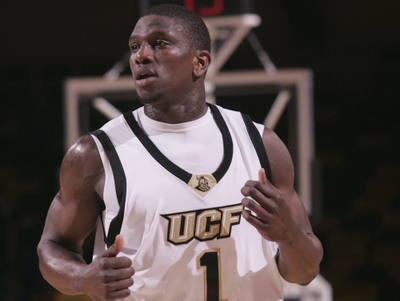
Joseph Treutlein
Its hard to argue that any player helped his stock at Portsmouth more than Jermaine Taylor, the most talked about player here this week, and the only one to spark mumblings of a potential first round selection. Measuring in at 64.5 in shoes while sporting an impressive 68.25 wingspan, Taylor helped himself both on and off the court this week.
In going back to analyze the tape we have of Taylor from Synergy Sports Technology, a few things stand out when comparing the footage to what we saw live. The most notable contrast is how much more evident Taylors athleticism was in this setting as opposed to at Central Florida, primarily due to the different level of defensive attention he was paid. At UCF, Taylor saw frequent double teams and aggressive weakside rotations on his drives to the rim, which in combination with his just adequate ball-handling led to him not being able to often fully utilize his athletic tools. Here at Portsmouth, being able to operate out of a Flex offense that put in many more isolation situations where he only needed a single dribble to get to the rim, and generally getting the ball with more space to operate, Taylor really shined, showing how explosive and versatile an athlete he really is.
Taylor doesnt have the greatest command of advanced ball-handling moves just yet, and his left hand is noticeably underdeveloped, but his slashing game is quite effective for other reasons, namely his strong first step in combination with his excellent body control and shiftiness with the ball in the lane. Hes terrific at making strong, aggressive moves coming off a screen or in other quick actions, showing great footwork and excellent body control. Also, while he isnt the most versatile ball-handler, hes effective enough with the ball in space and he shows a good understanding of his limitations, as evidenced by his outstanding 0.13 turnovers per possession this season, which is even more impressive given that Taylor has the third highest usage rate in our database.
Taylors well-developed frame allows him to finish through contact at the rim, while he also has a solid floater in his repertoire that he can utilize when necessary. His mid-range game is an effective weapon as well, being able to pull up in the 5-15 feet range going in either direction. Taylors body control on pull-up jumpers is exceptional, always staying upright with shoulders squared to the rim, however his release is prone to sloppiness when he has a hand in his face, leading to some errant misses.
Taylors jump shot in general is also impressive, as he shows range to the college three-point line with very strong form, being capable of scoring coming off screens, spotting up, or pulling up. As with his mid-range game, his release can get sloppy when a defender closes out hard, but otherwise his form is excellent.
As for the other aspects of his offensive game, Taylor shows solid court vision even though he didnt dish out many assists at UCF. His passing game is clearly a work in progress, as he definitely has a scorers mentality, and it showed when he tried to adjust his game at Portsmouth, leading to some ill-advised turnovers. Taylor is also aggressive on the offensive glass, using his combination of strength and athleticism to get his hands on balls over players much bigger than himself.
On the defensive end, Taylor is fairly unimpressive, not making use of his excellent physical tools consistently, showing an inconsistent stance with perimeter defense, not putting in consistent effort to move laterally, constantly lagging through screens off the ball, and showing a general lack of focus oftentimes. Still, its clear that he has considerable potential on this end of the floor with his wingspan and athleticism, and it does manifest from time to time, though he has a long way to go to even be an average defender by NBA standards.
Looking forward to the draft, Taylor clearly has an NBA body with NBA athleticism and some NBA skills, which is why there have began to be some mumblings about looks in the first round. Still, despite his incredible scoring talents, questions will remain about his shot-selection and lack of contributions in most other areas, namely defense. Taylor will certainly have some chance to make an NBA roster this year, but whether he sticks around will depend on how he develops his ball-handling, defense, and if he can adjust from an offensive focal point to playing in a smaller role.
In going back to analyze the tape we have of Taylor from Synergy Sports Technology, a few things stand out when comparing the footage to what we saw live. The most notable contrast is how much more evident Taylors athleticism was in this setting as opposed to at Central Florida, primarily due to the different level of defensive attention he was paid. At UCF, Taylor saw frequent double teams and aggressive weakside rotations on his drives to the rim, which in combination with his just adequate ball-handling led to him not being able to often fully utilize his athletic tools. Here at Portsmouth, being able to operate out of a Flex offense that put in many more isolation situations where he only needed a single dribble to get to the rim, and generally getting the ball with more space to operate, Taylor really shined, showing how explosive and versatile an athlete he really is.
Taylor doesnt have the greatest command of advanced ball-handling moves just yet, and his left hand is noticeably underdeveloped, but his slashing game is quite effective for other reasons, namely his strong first step in combination with his excellent body control and shiftiness with the ball in the lane. Hes terrific at making strong, aggressive moves coming off a screen or in other quick actions, showing great footwork and excellent body control. Also, while he isnt the most versatile ball-handler, hes effective enough with the ball in space and he shows a good understanding of his limitations, as evidenced by his outstanding 0.13 turnovers per possession this season, which is even more impressive given that Taylor has the third highest usage rate in our database.
Taylors well-developed frame allows him to finish through contact at the rim, while he also has a solid floater in his repertoire that he can utilize when necessary. His mid-range game is an effective weapon as well, being able to pull up in the 5-15 feet range going in either direction. Taylors body control on pull-up jumpers is exceptional, always staying upright with shoulders squared to the rim, however his release is prone to sloppiness when he has a hand in his face, leading to some errant misses.
Taylors jump shot in general is also impressive, as he shows range to the college three-point line with very strong form, being capable of scoring coming off screens, spotting up, or pulling up. As with his mid-range game, his release can get sloppy when a defender closes out hard, but otherwise his form is excellent.
As for the other aspects of his offensive game, Taylor shows solid court vision even though he didnt dish out many assists at UCF. His passing game is clearly a work in progress, as he definitely has a scorers mentality, and it showed when he tried to adjust his game at Portsmouth, leading to some ill-advised turnovers. Taylor is also aggressive on the offensive glass, using his combination of strength and athleticism to get his hands on balls over players much bigger than himself.
On the defensive end, Taylor is fairly unimpressive, not making use of his excellent physical tools consistently, showing an inconsistent stance with perimeter defense, not putting in consistent effort to move laterally, constantly lagging through screens off the ball, and showing a general lack of focus oftentimes. Still, its clear that he has considerable potential on this end of the floor with his wingspan and athleticism, and it does manifest from time to time, though he has a long way to go to even be an average defender by NBA standards.
Looking forward to the draft, Taylor clearly has an NBA body with NBA athleticism and some NBA skills, which is why there have began to be some mumblings about looks in the first round. Still, despite his incredible scoring talents, questions will remain about his shot-selection and lack of contributions in most other areas, namely defense. Taylor will certainly have some chance to make an NBA roster this year, but whether he sticks around will depend on how he develops his ball-handling, defense, and if he can adjust from an offensive focal point to playing in a smaller role.
Alade Aminu, 6-10, PF/C, Georgia Tech
16 points, 9 rebounds, 3 blocks, 2 turnovers, 54% FG, 57% FT
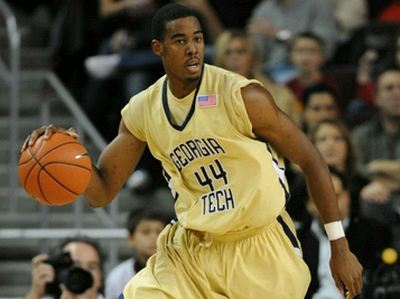
Jonathan Givony
The Georgia Tech big man stood out from the moment he stepped out on the court in his very first game, as it immediately became clear that few if any prospects in attendance share his upside.
Standing 6-10 (possibly taller), with a tremendous 7-3 wingspan and a frame that should be able to put on plenty of weight over the next few years, Aminu obviously has great physical attributes. Hes also a very good athlete as well, running the floor like a deer and very much capable of getting off the floor to finish around the rim or alter shots on the defensive end. He was after all, a track star in high school, competing in the triple jump, high jump, and 200-yard dash.
Aminu didnt play a very big role this season at Georgia Techin fact, he came off the bench for the teams final 12 games. The fact that he struggled to make an impact on a team that finished last in the ACC and posted a 12-19 record is a bit of a red flag, but as we learned the hard last year with the way Anthony Morrow panned out, players from this team need to be looked at a more in-depth, especially ones who are only 21 years old.
Comparing the way Aminu played at Portsmouth with what we can now see from his film at Georgia Tech reveals a pretty stark contrastit doesnt seem like he was utilized very well at all in college from what we can tell. Aminu was an absolute devastating force as a pick and roll finisher for his Norfolk Naval Shipyard teamthanks to his tremendous combination of size, length, terrific hands and excellent mobility. At Georgia Tech he was barely used in this fashion at alljust 4.3% of his offensive possessions came on the pick and roll. They looked incredibly disorganized in the film we took in, with no point guard, no system, and very little ball-movement. It appeared that Aminu often was asked to play very far from the basket, and pretty much all of his shots were opportunities that he was forced to create on his own.
In these types of situations, Aminus weaknesses became painfully obvious. Despite possessing an excellent frame, he lacks a great deal of strength at the moment, which makes it very difficult for him to comfortably operate on the court against top competition. He struggles to establish deep position in the post, and his footwork is very raw. He has a difficult time finishing through contact as well, again lacking strength but also some toughness, seemingly avoiding contact on occasion. He doesnt seem to know what his limitations are at the moment, making him fairly turnover prone, and contributing to his extremely poor passing ratiogarnering an assist on just 6% of his possessions.
Aminu has above average ball-handling skills for a player his size, but hes still a ways away from knowing how to utilize them at the moment. At times youll see him look very good putting the ball on the floor from the high post with his long strides, sometimes even mixing in a crafty spin move, but this part of his game remains underdeveloped, even if he shows nice potential with it. Aminus jump-shot is not consistentas evidenced by the 59% he shot from the line, but there is again stuff to work with here, as his mechanics are sound and he appears to have decent touch.
Defensively, Aminu is productive from a statistical standpointhes a solid (although not incredible) rebounder and comes up with plenty of blocks and steals thanks to his excellent size, length and athleticismbut here too he has a ways to gobeing somewhat stuck between the power forward and center positions. He lacks the strength and toughness to defend some of the more burly big men hell encounter from time to time, getting pushed around and giving up deep position in the post, while hes not fluid or fundamentally sound enough to guard face-up power forwards on the perimeter either, looking very upright trying to move his feet against them. He tends to lose his focus fairly easily and doesnt always seem to be playing as hard as he couldbecoming smarter and more mature are things he definitely needs to work on.
Aminu may not be very close to being a legit rotation player in the NBA at this point, but he shows outstanding potential to develop into one down the road. Considering that hes the same age as many juniors in this draft (he wont turn 22 until September), it wouldnt be surprising to see a team decide to take a flyer on him somewhere in the second round, even if being glued to an NBA bench would probably not be the best thing for his development.
Standing 6-10 (possibly taller), with a tremendous 7-3 wingspan and a frame that should be able to put on plenty of weight over the next few years, Aminu obviously has great physical attributes. Hes also a very good athlete as well, running the floor like a deer and very much capable of getting off the floor to finish around the rim or alter shots on the defensive end. He was after all, a track star in high school, competing in the triple jump, high jump, and 200-yard dash.
Aminu didnt play a very big role this season at Georgia Techin fact, he came off the bench for the teams final 12 games. The fact that he struggled to make an impact on a team that finished last in the ACC and posted a 12-19 record is a bit of a red flag, but as we learned the hard last year with the way Anthony Morrow panned out, players from this team need to be looked at a more in-depth, especially ones who are only 21 years old.
Comparing the way Aminu played at Portsmouth with what we can now see from his film at Georgia Tech reveals a pretty stark contrastit doesnt seem like he was utilized very well at all in college from what we can tell. Aminu was an absolute devastating force as a pick and roll finisher for his Norfolk Naval Shipyard teamthanks to his tremendous combination of size, length, terrific hands and excellent mobility. At Georgia Tech he was barely used in this fashion at alljust 4.3% of his offensive possessions came on the pick and roll. They looked incredibly disorganized in the film we took in, with no point guard, no system, and very little ball-movement. It appeared that Aminu often was asked to play very far from the basket, and pretty much all of his shots were opportunities that he was forced to create on his own.
In these types of situations, Aminus weaknesses became painfully obvious. Despite possessing an excellent frame, he lacks a great deal of strength at the moment, which makes it very difficult for him to comfortably operate on the court against top competition. He struggles to establish deep position in the post, and his footwork is very raw. He has a difficult time finishing through contact as well, again lacking strength but also some toughness, seemingly avoiding contact on occasion. He doesnt seem to know what his limitations are at the moment, making him fairly turnover prone, and contributing to his extremely poor passing ratiogarnering an assist on just 6% of his possessions.
Aminu has above average ball-handling skills for a player his size, but hes still a ways away from knowing how to utilize them at the moment. At times youll see him look very good putting the ball on the floor from the high post with his long strides, sometimes even mixing in a crafty spin move, but this part of his game remains underdeveloped, even if he shows nice potential with it. Aminus jump-shot is not consistentas evidenced by the 59% he shot from the line, but there is again stuff to work with here, as his mechanics are sound and he appears to have decent touch.
Defensively, Aminu is productive from a statistical standpointhes a solid (although not incredible) rebounder and comes up with plenty of blocks and steals thanks to his excellent size, length and athleticismbut here too he has a ways to gobeing somewhat stuck between the power forward and center positions. He lacks the strength and toughness to defend some of the more burly big men hell encounter from time to time, getting pushed around and giving up deep position in the post, while hes not fluid or fundamentally sound enough to guard face-up power forwards on the perimeter either, looking very upright trying to move his feet against them. He tends to lose his focus fairly easily and doesnt always seem to be playing as hard as he couldbecoming smarter and more mature are things he definitely needs to work on.
Aminu may not be very close to being a legit rotation player in the NBA at this point, but he shows outstanding potential to develop into one down the road. Considering that hes the same age as many juniors in this draft (he wont turn 22 until September), it wouldnt be surprising to see a team decide to take a flyer on him somewhere in the second round, even if being glued to an NBA bench would probably not be the best thing for his development.
Jon Brockman, 6-7, PF, Washington
15.3 Points, 16.3 Rebounds, 2.3 Assists, 1.3 Steals, 3.3 Turnovers, 45.2% FG, 72.7% FT
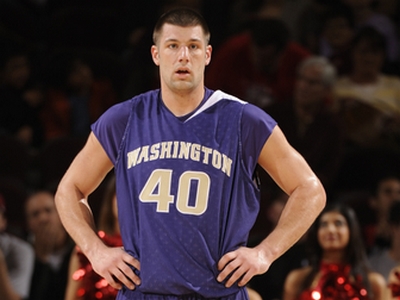
The former McDonalds All-American set the tone for the week with a 21 rebound performance in his first game in Portsmouth. Despite his team dropping their game in the consolation bracket, few players performed as well as Brockman. Though his height hurts his upside, he was easily one of the most interesting prospects from an NBA perspective at this years edition of the PIT.
Only measuring in at 6-7 without shoes, with a very underwhelming 6-7 ¾ wingspan, Brockman is clearly undersized for the power forward position, and he doesnt make up for it with elite athleticism. His 252-pound frame is his biggest asset from a purely physical perspective. Built like a tank, the former Husky loves to throw his weight around on the block, playing with great toughness and a high motor. Though hes not a great athlete, Brockman shows decent leaping ability for his size on the move, and could become an even better physical specimen if he continues to work on his athleticism. His size will always be one of the biggest knocks against him, making it that much more important that he maximize the other parts of his game.
Possessing an ideal frame to handle the rigors of the post in the NCAA, Brockmans collegiate numbers reflected his aggressive interior mentality as well as a shift in his role. After coming into his own during a sophomore season that saw him assume a major role in Lorenzo Romars offense, Brockman was one of the top scorers and rebounders in the PAC-10 as a junior. The emergence of freshman Isaiah Thomas limited his touches last season, but Brockman maintained his efficiency and actually improved his rebounding rate. His constant hustle has landed him amongst the top rebounders in the nation, and the sacrifices he made as a senior ultimately helped his team win the Pac-10, and advance to the second round of the NCAA tournament.
Brockmans willingness to shift his role to help his team is a good sign for the bruising forward moving ahead, and it showed during the PIT. After getting almost half of his touches in the post during his last two seasons in Seattle, Brockman will need to earn his touches by working without the ball something he did very effectively all week. Using his great lower body strength to get leverage and gain position on the inside, he did a terrific job bullying his way into the lane. Finishing the week averaging 9 offensive rebounds per game, Brockman did most of his damage with flash cuts, duck-ins, and put-backs. Since his size will limit his back to the basket game on the next level, it was good to see him produce so effectively without the ball in his hands.
While Brockmans ability to create touches for himself was impressive, he didnt finish all that well at the rim, as he lacks the length and explosiveness to be very effective here. He needs to continue to diversify his offensive game to avoid being a liability, since his problems around the basket is very much an indication of the issues hell face against more athletic defensive players in the NBA. Brockman did attempt a couple of jumpers, but displayed the same flat mechanics that made him an inconsistent shooter during his days as a Husky. It will be important for him to develop his jump-shot to account for the decline in efficiency hes sure to endure in the paint.
Defensively, Brockman did a good job using his physicality to harass his man, getting away with more than he did during his days at Washington when he ranked amongst the most foul prone players in the NCAA. He gave up no ground in the post, showed average lateral quickness defending the perimeter, and effectively hedged the pick and roll on a couple of occasions. Not as dominant on the defensive glass as he was as an offensive rebounder, Brockman did a good job boxing out this week, and though he isnt the type of elite athlete that is going to explode across the lane to pull down rebounds, hes a very good defensive rebounder. He displays great hands and pulls down tough boards in traffic, which is important considering he doesnt provide much of a presence as a help side defender or create many turnovers.
Overall, this was a great week for Jon Brockman. He may have slowed down as the week went on, but he was easily one of the most productive players here. Making his ability to impact the game as a hustle player incredibly apparent to all the many NBA talent evaluators in attendance, Brockman likely helped his cause considerably, and may now have a chance to be drafted somewhere in the second round. Even if he doesnt hear his name called on draft night, hes the type of player who could easily endear himself to a coaching staff and make a roster in training camp. If not, there will be plenty of six-figure offers thrown his way from Europe.
Only measuring in at 6-7 without shoes, with a very underwhelming 6-7 ¾ wingspan, Brockman is clearly undersized for the power forward position, and he doesnt make up for it with elite athleticism. His 252-pound frame is his biggest asset from a purely physical perspective. Built like a tank, the former Husky loves to throw his weight around on the block, playing with great toughness and a high motor. Though hes not a great athlete, Brockman shows decent leaping ability for his size on the move, and could become an even better physical specimen if he continues to work on his athleticism. His size will always be one of the biggest knocks against him, making it that much more important that he maximize the other parts of his game.
Possessing an ideal frame to handle the rigors of the post in the NCAA, Brockmans collegiate numbers reflected his aggressive interior mentality as well as a shift in his role. After coming into his own during a sophomore season that saw him assume a major role in Lorenzo Romars offense, Brockman was one of the top scorers and rebounders in the PAC-10 as a junior. The emergence of freshman Isaiah Thomas limited his touches last season, but Brockman maintained his efficiency and actually improved his rebounding rate. His constant hustle has landed him amongst the top rebounders in the nation, and the sacrifices he made as a senior ultimately helped his team win the Pac-10, and advance to the second round of the NCAA tournament.
Brockmans willingness to shift his role to help his team is a good sign for the bruising forward moving ahead, and it showed during the PIT. After getting almost half of his touches in the post during his last two seasons in Seattle, Brockman will need to earn his touches by working without the ball something he did very effectively all week. Using his great lower body strength to get leverage and gain position on the inside, he did a terrific job bullying his way into the lane. Finishing the week averaging 9 offensive rebounds per game, Brockman did most of his damage with flash cuts, duck-ins, and put-backs. Since his size will limit his back to the basket game on the next level, it was good to see him produce so effectively without the ball in his hands.
While Brockmans ability to create touches for himself was impressive, he didnt finish all that well at the rim, as he lacks the length and explosiveness to be very effective here. He needs to continue to diversify his offensive game to avoid being a liability, since his problems around the basket is very much an indication of the issues hell face against more athletic defensive players in the NBA. Brockman did attempt a couple of jumpers, but displayed the same flat mechanics that made him an inconsistent shooter during his days as a Husky. It will be important for him to develop his jump-shot to account for the decline in efficiency hes sure to endure in the paint.
Defensively, Brockman did a good job using his physicality to harass his man, getting away with more than he did during his days at Washington when he ranked amongst the most foul prone players in the NCAA. He gave up no ground in the post, showed average lateral quickness defending the perimeter, and effectively hedged the pick and roll on a couple of occasions. Not as dominant on the defensive glass as he was as an offensive rebounder, Brockman did a good job boxing out this week, and though he isnt the type of elite athlete that is going to explode across the lane to pull down rebounds, hes a very good defensive rebounder. He displays great hands and pulls down tough boards in traffic, which is important considering he doesnt provide much of a presence as a help side defender or create many turnovers.
Overall, this was a great week for Jon Brockman. He may have slowed down as the week went on, but he was easily one of the most productive players here. Making his ability to impact the game as a hustle player incredibly apparent to all the many NBA talent evaluators in attendance, Brockman likely helped his cause considerably, and may now have a chance to be drafted somewhere in the second round. Even if he doesnt hear his name called on draft night, hes the type of player who could easily endear himself to a coaching staff and make a roster in training camp. If not, there will be plenty of six-figure offers thrown his way from Europe.
Paul Delaney III, 6-2, Point Guard, UAB
15 points, 6 rebounds, 4.3 assists, 2.7 turnovers, 46% FG, 20% 3P, 63% FT, 31 minutes
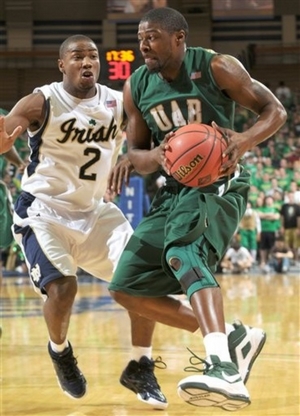
Jonathan Givony
One of the biggest surprises of the Portsmouth Invitational Tournament, Paul Delaney III did an excellent acquainting himself with the many NBA talent evaluators in attendance here, to the point that he began to receive mention as a sleeper pick to slip into the second round by the time the camp was over.
Delaneys biggest assets clearly revolve around his excellent physical attributesstanding a solid 6-2, with a freakish 6-9 wingspan, and a chiseled 197 pound frame that hes not afraid to utilize. Hes an excellent athlete, showing a terrific first step, great speed in the open floor, and the explosiveness needed to rise up over the top of defenses and finish with an emphatic dunk.
Primarily a slasher in the half-court, Delaney sports one of college basketballs best 2-point percentages amongst point guards, at an outstanding 60%. He takes the ball incredibly hard to the basketbeing better going leftand finishes ferociously once there, thanks to his excellent length, strength and leaping ability. His ball-handling skills are improvable in pure one on one half-court situations, but once he gets a full head of steam, hes extremely difficult to keep out of the lane. Hes at his best in transition, where his end to end speed and excellent body control really shines.
Delaneys point guard skills are mostly a mixed bag at this point, which is not a surprise considering that he doesnt play the position full time for UAB. One on hand he shows the ability to break down the defense and find the open man in drive and dish situations, sometimes in impressive fashion, but his feel for running a team looks underdeveloped at this point, especially in half-court situations. He tends to commit careless turnovers, often looking out of control, and doesnt appear very adept at running the pick and roll.
From a statistical standpoint, his numbers are extremely underwhelming, as his 3.9 assists per-40 pace adjusted would rank 19th out of the 20 NCAA point guards currently projected to be drafted in our 2009 or 2010 mock drafts.
As a shooter is where Delaney needs to improve the mosthe only made 22 3-pointers in 33 games this past season, and sports slow, ugly looking shooting mechanics, that dont leave a great deal of room for optimism in this regard. He only made 1 of 5 attempts from beyond the arc at the PIT, looking very limited shooting off the dribble in particular. Teams tended to go way underneath screens in pick and roll situations in the UAB film we evaluated, which tells you a great deal about what they thought of his jump-shot.
Defensively, Delaney has great tools, as his size, length and terrific lateral quickness gives him excellent potential on this end of the floor. Hes not very fundamentally sound, though, and doesnt seem to consistently put the effort in, particularly with his off-ball defense, but he should be able to develop this part of his game considerably if he chooses to do so. He seems to have excellent anticipation skills and outstanding hands, which helps him get in the passing lanes on a regular basis. Hes also a solid defensive rebounder for his position, again thanks to his terrific physical tools.
Despite his fairly underwhelming college careerputting up so-so numbers on an average teamDelaney was able to make up considerable ground over the past week thanks to his strong play at the PIT. His physical attributes give him some upside to grow into that most NCAA senior point guards outside the first round usually dont have, which may lead a team to give him a chance at making a roster, either through summer league or training camp. Hes a little bit older than most due to redshirting last season after tearing his ACL (and was sporting a fairly big brace on his knee at Portsmouth), but that shouldnt make that much of a difference in the decision making process.
Delaneys biggest assets clearly revolve around his excellent physical attributesstanding a solid 6-2, with a freakish 6-9 wingspan, and a chiseled 197 pound frame that hes not afraid to utilize. Hes an excellent athlete, showing a terrific first step, great speed in the open floor, and the explosiveness needed to rise up over the top of defenses and finish with an emphatic dunk.
Primarily a slasher in the half-court, Delaney sports one of college basketballs best 2-point percentages amongst point guards, at an outstanding 60%. He takes the ball incredibly hard to the basketbeing better going leftand finishes ferociously once there, thanks to his excellent length, strength and leaping ability. His ball-handling skills are improvable in pure one on one half-court situations, but once he gets a full head of steam, hes extremely difficult to keep out of the lane. Hes at his best in transition, where his end to end speed and excellent body control really shines.
Delaneys point guard skills are mostly a mixed bag at this point, which is not a surprise considering that he doesnt play the position full time for UAB. One on hand he shows the ability to break down the defense and find the open man in drive and dish situations, sometimes in impressive fashion, but his feel for running a team looks underdeveloped at this point, especially in half-court situations. He tends to commit careless turnovers, often looking out of control, and doesnt appear very adept at running the pick and roll.
From a statistical standpoint, his numbers are extremely underwhelming, as his 3.9 assists per-40 pace adjusted would rank 19th out of the 20 NCAA point guards currently projected to be drafted in our 2009 or 2010 mock drafts.
As a shooter is where Delaney needs to improve the mosthe only made 22 3-pointers in 33 games this past season, and sports slow, ugly looking shooting mechanics, that dont leave a great deal of room for optimism in this regard. He only made 1 of 5 attempts from beyond the arc at the PIT, looking very limited shooting off the dribble in particular. Teams tended to go way underneath screens in pick and roll situations in the UAB film we evaluated, which tells you a great deal about what they thought of his jump-shot.
Defensively, Delaney has great tools, as his size, length and terrific lateral quickness gives him excellent potential on this end of the floor. Hes not very fundamentally sound, though, and doesnt seem to consistently put the effort in, particularly with his off-ball defense, but he should be able to develop this part of his game considerably if he chooses to do so. He seems to have excellent anticipation skills and outstanding hands, which helps him get in the passing lanes on a regular basis. Hes also a solid defensive rebounder for his position, again thanks to his terrific physical tools.
Despite his fairly underwhelming college careerputting up so-so numbers on an average teamDelaney was able to make up considerable ground over the past week thanks to his strong play at the PIT. His physical attributes give him some upside to grow into that most NCAA senior point guards outside the first round usually dont have, which may lead a team to give him a chance at making a roster, either through summer league or training camp. Hes a little bit older than most due to redshirting last season after tearing his ACL (and was sporting a fairly big brace on his knee at Portsmouth), but that shouldnt make that much of a difference in the decision making process.
Leo Lyons, 610, Power Forward, Missouri
13.7 points, 7.7 rebounds, 2.0 assists, 1.0 block, 2.3 turnovers, 15-34 FG, 10-15 FT, 1-6 3PT
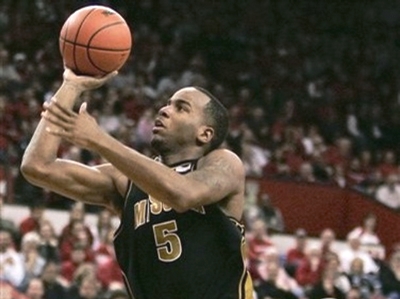
Joseph Treutlein
One of the more skilled and physically gifted players in attendance, Leo Lyons put his strengths and weaknesses on full display here in Portsmouth. Since we last wrote about him prior to the season, not much substantial has changed, though there are a few observations to be made. While Lyons measured in at a strong 69.75 in shoes, its tempered a bit by his 610.75 wingspan, which is just average for his size.
On the offensive end, Lyons is an incredibly versatile player, capable of scoring inside and out in a variety of ways. Taking the ball to the basket, Lyons can attack with either hand while mixing in occasionally advanced moves such as spins, crossovers, or behind-the-back dribbles. Hes not an incredibly quick or explosive athlete, but hes very smooth and coordinated for his size, and possesses very long strides with a relatively controlled handle. The main problem with Lyons dribble-drive game is his at times questionable decision-making, as hes prone to forcing the issue or playing outside his limitations.
In the lane, Lyons is capable of finishing with either hand and has the fluidity to adjust in mid-air, using reverses, pump fakes, and finishing through contact with regularity. Interestingly enough, Lyons actually ranks third in our entire database (behind Blake Griffin) in free throws attempted per 40 minutes pace adjusted, telling you just how tenacious he is attacking the rim. Lyons does a good job of cutting to the basket without the ball and leaking out in transition, while he also has a lot of ability as an offensive rebounder, though he doesnt always make use of his abilities consistently there.
Lyons jump shot has been up and down over his four years at Missouri, as despite showing great form and shooting touch at times, hes prone to bad misses due to a lack of discipline in shot selection along with some sloppy tendencies. When he gets his feet set and his shoulders squared, Lyons is a very accurate shooter out to 18 feet, even when hes fading away and/or contested. Unfortunately, though, Lyons is prone to rushing his shot at times, pulling the string on his follow through, or drifting in different directions unnecessarily, leading to inconsistency in his effectiveness. With better discipline and more consistent mechanics, Lyons has the potential to become a deadly mid-range shooter, and maybe more, as hes shown brief flashes of range out to the college three-point line.
On the defensive end, Lyons has had many well-documented issues prior to this season, and while hes made some strides, many of them still remain. On the positive side, Lyons attentiveness and activity level as a perimeter defender is definitely improved this season, however hes still inconsistent in doing some of the little things--giving up too much space to shooters, not putting in the effort laterally, and not staying in a fundamental stance. It is worth noting that during Missouris NCAA tournament run, however, most of these problems were hardly evident at all, as Lyons looked like a different player on the perimeter, playing excellent fundamental defense, moving his feet well, aggressively hedging pick-and-rolls, and really showing what hes capable of. On the negative side, Lyons post defense and boxing out on the glass has not been impressive all season, as he shows little grasp of leverage, doesnt fight hard for position, and just is not very effective defending in the painted area.
Despite his considerable talent, he only averaged 23 minutes per game at Missouri, partially due to foul problems (4.3 fouls per per-40), and partially due to the large rotation Mike Anderson likes to employ in their very up-tempo 40 minutes of hell style pressure defense. This also had a lot to do with his average awareness and basketball IQ, as you never quite got the feeling that Lyons was always on page with his coaching staffwho werent the ones who brought him to Missouri.
Looking forward to the NBA draft, Lyons will most likely be in a lot of second round discussions, as despite his flaws, he will be one of the most naturally talented players on the board as draft night winds down. The caveat to this is that in spite of his talent, Lyons is still a good ways away from putting it all together, as he has a lot of adjustments to make to his game in order to maximize his abilities and become a consistent all-around player. Still, that is what the NBA draft is all about after all.
On the offensive end, Lyons is an incredibly versatile player, capable of scoring inside and out in a variety of ways. Taking the ball to the basket, Lyons can attack with either hand while mixing in occasionally advanced moves such as spins, crossovers, or behind-the-back dribbles. Hes not an incredibly quick or explosive athlete, but hes very smooth and coordinated for his size, and possesses very long strides with a relatively controlled handle. The main problem with Lyons dribble-drive game is his at times questionable decision-making, as hes prone to forcing the issue or playing outside his limitations.
In the lane, Lyons is capable of finishing with either hand and has the fluidity to adjust in mid-air, using reverses, pump fakes, and finishing through contact with regularity. Interestingly enough, Lyons actually ranks third in our entire database (behind Blake Griffin) in free throws attempted per 40 minutes pace adjusted, telling you just how tenacious he is attacking the rim. Lyons does a good job of cutting to the basket without the ball and leaking out in transition, while he also has a lot of ability as an offensive rebounder, though he doesnt always make use of his abilities consistently there.
Lyons jump shot has been up and down over his four years at Missouri, as despite showing great form and shooting touch at times, hes prone to bad misses due to a lack of discipline in shot selection along with some sloppy tendencies. When he gets his feet set and his shoulders squared, Lyons is a very accurate shooter out to 18 feet, even when hes fading away and/or contested. Unfortunately, though, Lyons is prone to rushing his shot at times, pulling the string on his follow through, or drifting in different directions unnecessarily, leading to inconsistency in his effectiveness. With better discipline and more consistent mechanics, Lyons has the potential to become a deadly mid-range shooter, and maybe more, as hes shown brief flashes of range out to the college three-point line.
On the defensive end, Lyons has had many well-documented issues prior to this season, and while hes made some strides, many of them still remain. On the positive side, Lyons attentiveness and activity level as a perimeter defender is definitely improved this season, however hes still inconsistent in doing some of the little things--giving up too much space to shooters, not putting in the effort laterally, and not staying in a fundamental stance. It is worth noting that during Missouris NCAA tournament run, however, most of these problems were hardly evident at all, as Lyons looked like a different player on the perimeter, playing excellent fundamental defense, moving his feet well, aggressively hedging pick-and-rolls, and really showing what hes capable of. On the negative side, Lyons post defense and boxing out on the glass has not been impressive all season, as he shows little grasp of leverage, doesnt fight hard for position, and just is not very effective defending in the painted area.
Despite his considerable talent, he only averaged 23 minutes per game at Missouri, partially due to foul problems (4.3 fouls per per-40), and partially due to the large rotation Mike Anderson likes to employ in their very up-tempo 40 minutes of hell style pressure defense. This also had a lot to do with his average awareness and basketball IQ, as you never quite got the feeling that Lyons was always on page with his coaching staffwho werent the ones who brought him to Missouri.
Looking forward to the NBA draft, Lyons will most likely be in a lot of second round discussions, as despite his flaws, he will be one of the most naturally talented players on the board as draft night winds down. The caveat to this is that in spite of his talent, Lyons is still a good ways away from putting it all together, as he has a lot of adjustments to make to his game in order to maximize his abilities and become a consistent all-around player. Still, that is what the NBA draft is all about after all.















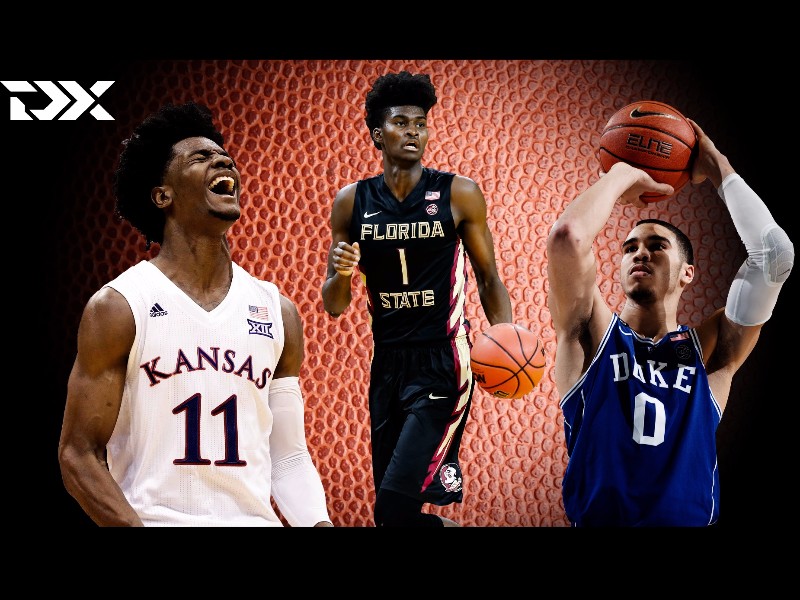
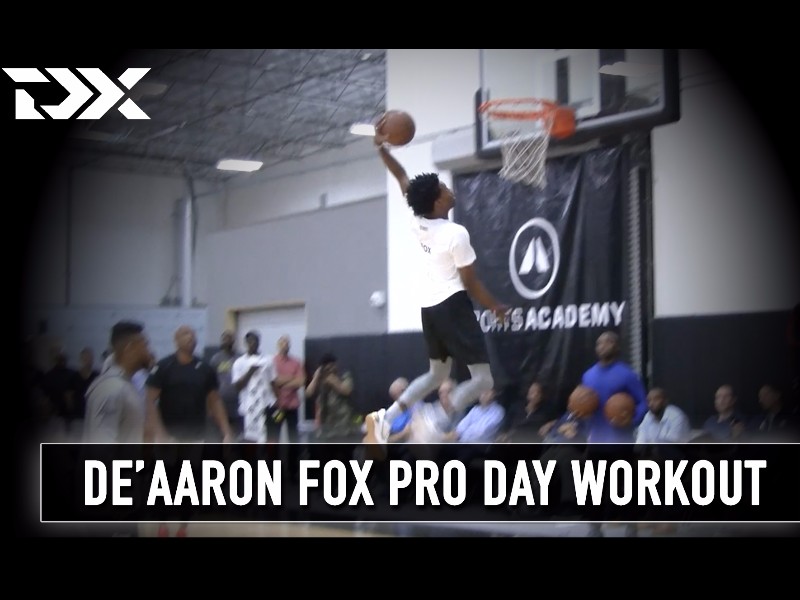


















Comments